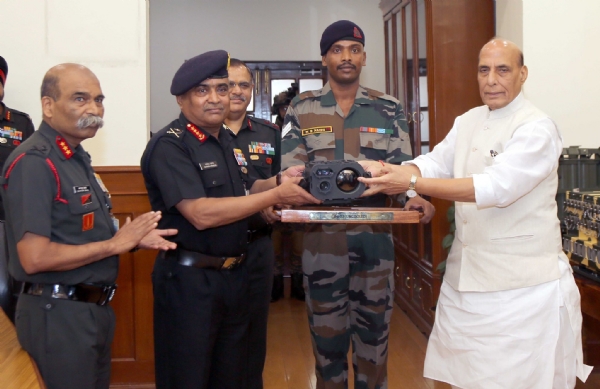Rajnath Singh hands over "these" multiple indigenous weapons to Indian Army; mainly for northern borders
16 Aug 2022 16:45:33
New Delhi, Aug 16: Defence Minister Rajnath Singh handed over indigenously-developed equipment and systems to the Indian Army on Tuesday. These include Future Infantry Soldier as a System (F-INSAS).
The equipment/systems have been jointly developed by Indian Army in collaboration with Defence Public Sector Undertakings, Defence Research & Development Organisation (DRDO) and the Industry. The aim is to boost the Made-In-India and Atmanibhar Bharat initatives.

The equipment and systems handed over to the Indian Army are as follow:
1. Future Infantry Soldier as a System
2. Anti-Personnel mine ‘Nipun’: It will enhance the protection provided to the troops on the borders. The mine is more potent and effective than the existing anti-personnel mine.
3. Hand Held Thermal Imager (Uncooled): It is for surveillance and detection. It gives visibility in both day and night and in adverse weather conditions to the soldiers to detect enemy movement and activities.
Commander Thermal Imaging Sight for T-90 tank: It gives enhanced visibility and range to the commanders of armoured columns. Earlier, in T-90 tanks had image intensification systems which had its own limitations and constraints. The limitations have been overcome by use of thermal imaging sight produced by India Optel Limited.
Downlink Equipment with Recording Facility: It helps the helicopters in carrying out constant reconnaissance and surveillance of the borders and operational areas. While on missions, reconnaissance data observed is recorded in the system and can be accessed only when the helicopter returns to the base.
Semi Ruggedised Automatic Exchange System Mk-II: It has been developed by the Bharat Electronics Limited, Kotdwar, which overcomes all inadequacies of the older system.
Upgraded Radio Relay (Frequency Hopping): With this radio relay system, forward troops are in a position to operate their communication equipment and radio sets at much longer ranges and in greater depths than hither-to-fore. This is an advanced system with frequency hopping technology and very high capacity.
Solar Photovoltaic Energy Project: One of the most challenging terrain and operational sectors of the country is the Siachen Glacier. The complete power requirement in the area to operate various equipment was met only through captive generator supply. A solar photo-voltaic plant has been installed to improve the overall energy requirements and also obviate dependence on fossil fuels.
Landing Craft Assault (LCA): There are boats operating in Pangong Tso lake, however, they have limited capabilities. The LCA is much more versatile and has overcome the limitations of launch, speed and capacity. It has enhanced the capability to operate across the water obstacles in Eastern Ladakh.
Mini Remotely Piloted Aerial System (RPAS): It removes the operational limitations faced by the Indian Air Force aircraft and the heron Unmanned Aerial Vehicles at tactical level. It empowers the Indian Army by removing the restricted capability for surveillance, detection and reconnaissance at the infantry battalion and mechanised units level.
Infantry Protected Mobility Vehicle (IPMV): It provides mobility and more protection to a large number of infantry soldiers posted at the Northern Borders.
Quick Reaction Fighting Vehicle (Medium): It facilitates quick deployment of troops and will enable much faster reaction. The vehicles have been procured from Tata Advanced Systems Ltd. These are tailor-made vehicles with high mobility, enhanced firepower & protection. It will facilitate creating moral ascendency in our Northern Borders.